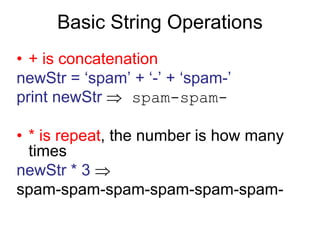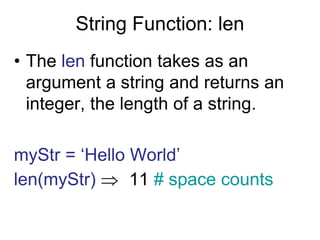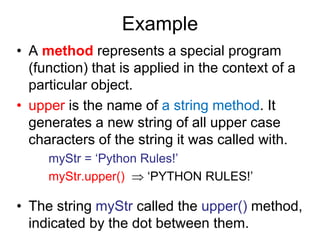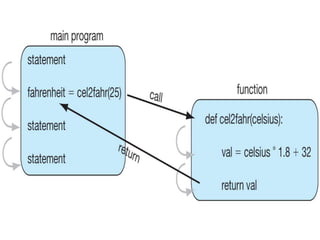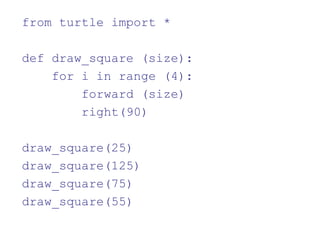A program is a sequence of instructions that are run by the processor. To run a program, it must be compiled into binary code and given to the operating system. The OS then gives the code to the processor to execute. Functions allow code to be reused by defining operations and returning values. Strings are sequences of characters that can be accessed by index and manipulated with methods like upper() that return new strings.


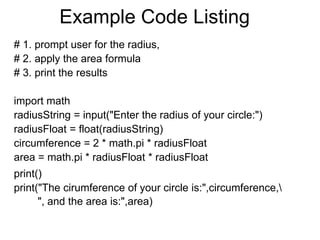
![Getting Input
The function: input(“Give me a value”)
• prints “Give me a value” on the screen and
waits until the user types something
(anything), ending with [Enter] key
• Warning! Input() returns a string (sequence
of characters), no matter what is given. (‘1’ is
not the same as 1, different types)
Convert from string to integer
• Python requires that you must convert a sequence
of characters to an integer
• Once converted, we can do math on the integers](https://image.slidesharecdn.com/rlxup7xhtrigz9cimjje-signature-0762a8c9312704fceea2364892c07409daf56c3672d9678e5c1f617b777fd1dc-poli-160505164100/85/Python-basics-4-320.jpg)
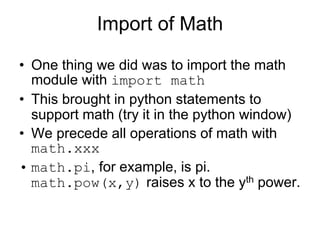



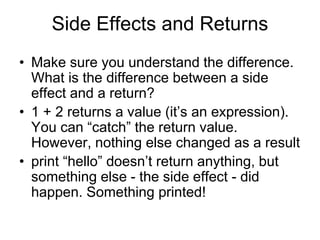
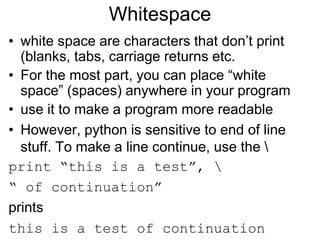
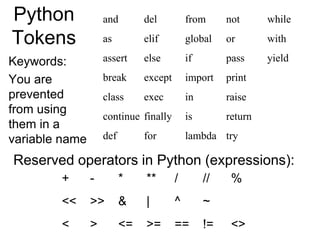
![Python Punctuators
• Python punctuation/delimiters ($ and ? not
allowed).
‘ “ #
( ) [ ] { } @
, : . ` = ;
+= -= *= /= //= %=
&= |= ^= >>= <<= **=](https://image.slidesharecdn.com/rlxup7xhtrigz9cimjje-signature-0762a8c9312704fceea2364892c07409daf56c3672d9678e5c1f617b777fd1dc-poli-160505164100/85/Python-basics-12-320.jpg)
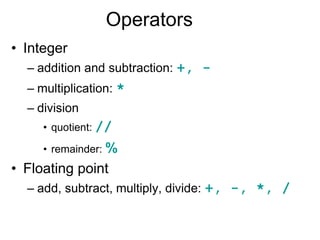
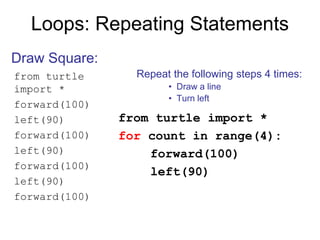

![Range Function
• The range function generates a sequence
of integers
• range(5) => [0, 1, 2, 3, 4]
– assumed to start at 0
– goes up to, but does not include, the provided
number argument.
• range(3,10) => [3, 4, 5, 6, 7, 8, 9]
– first argument is the number to begin with
– second argument is the end limit (not included!)](https://image.slidesharecdn.com/rlxup7xhtrigz9cimjje-signature-0762a8c9312704fceea2364892c07409daf56c3672d9678e5c1f617b777fd1dc-poli-160505164100/85/Python-basics-16-320.jpg)
![Iterating Through the Sequence
for num in range(1,5):
print(num)
• range generates the sequence [1, 2, 3, 4]
• for loop assigns num each of the values in
the sequence, one at a time in sequence
• prints each number (one number per line)
• list(range(-5,5)) # in shell to show range](https://image.slidesharecdn.com/rlxup7xhtrigz9cimjje-signature-0762a8c9312704fceea2364892c07409daf56c3672d9678e5c1f617b777fd1dc-poli-160505164100/85/Python-basics-17-320.jpg)

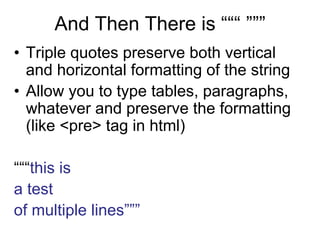
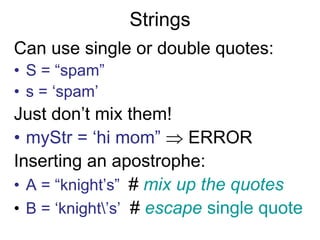

![Accessing an Element
• A particular element of the string is accessed by
the index of the element surrounded by square
brackets [ ]
helloStr = ‘Hello World’
print helloStr[1] => prints ‘e’
print helloStr[-1] => prints ‘d’
print helloStr[11] => ERROR](https://image.slidesharecdn.com/rlxup7xhtrigz9cimjje-signature-0762a8c9312704fceea2364892c07409daf56c3672d9678e5c1f617b777fd1dc-poli-160505164100/85/Python-basics-22-320.jpg)
